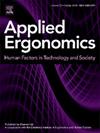Prolonged low-frequency force depression recovery response following an isometric triceps extension to volitional fatigue at a high versus low intensity contraction
IF 3.1
2区 工程技术
Q2 ENGINEERING, INDUSTRIAL
引用次数: 0
Abstract
Objective
To investigate the recovery of prolonged low-frequency force depression (PLFFD) within the first hour post-volitional fatigue following a sustained isometric triceps contraction performed at high (70 % of maximum voluntary force (MVF)) and low (20 % of MVF) intensities.
Background
High threshold and low threshold motor units contribute differently to force generation capability and fatigue at different rates. However, we know little about how high and low threshold motor units recover following fatiguing contractile activity.
Methods
Fourteen males and fourteen females sustained an isometric elbow extensor contraction until volitional fatigue at high (70 % MVF) and low (20 % MVF) intensities. The ratio of force generated by transcutaneous muscle stimulation of the triceps at 20 Hz and 100 Hz frequencies was measured at baseline and intermittently for 1 h post fatigue to characterize PLFFD.
Results
The 20/100 Hz force ratio was initially (0–4 min) significantly greater (meaning less force depression) following the high intensity protocol. However, the 20/100 Hz ratio for both intensities was similar for the duration of recovery thereafter.
Conclusion
Initial differences in the 20/100 Hz ratio within the first 0–4 min are likely explained by post-activation potentiation following the higher intensity submaximal contraction. However, the similarity in the recovery of 20/100 Hz ratio thereafter supports the hypothesis that once PLFFD is present, the recovery rate may be independent from how fatigue and corresponding PLFFD developed.
Application
The practical impact is that recovery of prolonged frequency fatigue may not depend on the intensity of the contraction that caused the fatigue.
在高强度与低强度收缩时,肱三头肌等距伸展至意志疲劳后的长时间低频力下降恢复反应
目的探讨高强度(70%的最大自主力)和低强度(20%的最大自主力)持续等长肱三头肌收缩后1小时内延长的低频力抑制(PLFFD)的恢复情况。背景:高阈值和低阈值运动单元以不同的速率对力产生能力和疲劳有不同的贡献。然而,我们对高阈值和低阈值运动单元如何在疲劳收缩活动后恢复知之甚少。方法在高(70% MVF)和低(20% MVF)强度下,14名男性和14名女性持续等距肘伸肌收缩,直到意志疲劳。以20 Hz和100 Hz频率经皮肱三头肌刺激产生的力的比率在基线和间歇性疲劳后1小时进行测量,以表征PLFFD。结果在高强度方案下,20/100 Hz力比在初始(0-4 min)显著增大(即力降较小)。然而,在此后的恢复期间,两种强度的20/100 Hz比率是相似的。结论20/100 Hz比值在前0 ~ 4 min的初始差异可能与高强度次极大收缩后的激活后增强有关。然而,20/100 Hz比率恢复的相似性支持了这样的假设,即一旦出现PLFFD,恢复速率可能与疲劳和相应的PLFFD如何发展无关。实际影响是,长时间频率疲劳的恢复可能不依赖于引起疲劳的收缩强度。
本文章由计算机程序翻译,如有差异,请以英文原文为准。
求助全文
约1分钟内获得全文
求助全文
来源期刊

Applied Ergonomics
工程技术-工程:工业
CiteScore
7.50
自引率
9.40%
发文量
248
审稿时长
53 days
期刊介绍:
Applied Ergonomics is aimed at ergonomists and all those interested in applying ergonomics/human factors in the design, planning and management of technical and social systems at work or leisure. Readership is truly international with subscribers in over 50 countries. Professionals for whom Applied Ergonomics is of interest include: ergonomists, designers, industrial engineers, health and safety specialists, systems engineers, design engineers, organizational psychologists, occupational health specialists and human-computer interaction specialists.
 求助内容:
求助内容: 应助结果提醒方式:
应助结果提醒方式:


